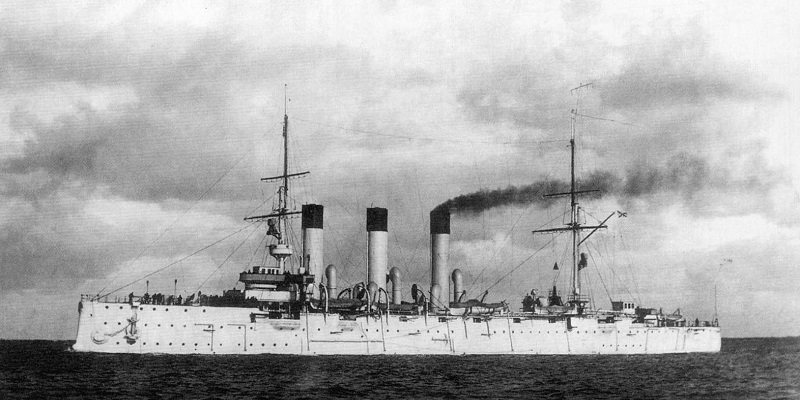As many have learned recently, Russia has a naval base in Tartus, Syria. More importantly, we should understand that Russia’s interest in the Mediterranean is a tradition dating back before World War I, an interest that shaped Russia’s position in that war.
When Russia was still an empire, Tsar Nicholas II (r. 1894-1917) saw the future of his empire in the Far East. ((Christopher Clark, The Sleepwalkers: How Europe went to War in 1914 (New York: HarperCollins, 2013), 176.)) As he sought influence in Korea and China, this put him in direct competition with the Empire of Japan. After a devastating loss in the Russo-Japanese War (1904-5), Nicholas II turned to the west, specifically the Turkish Straits, which would give him access from the Black Sea to the Aegean Sea, and thus the Mediterranean. ((Ibid., 188.))
Over the next decade, Russia’s desire for access and more influence in the Straits coupled with the dwindling dominance of the Ottoman Empire would mold Russia’s position in World War I.
For example, Russian foreign minister Alexander Izvolsky proposed Austria-Hungary annex Bosnia-Herzegovina in 1908 in return for support of better Russian access to the Turkish Straits. ((Luigi Albertini, The Origins of the War of 1914, vol. 1, translated and edited by Isabella M. Massey (New York: Enigma Books, 2005), 206; Clark 2013, 36, 85.)) Keep in mind Russia would be at war with Austria-Hungary a mere six years later. Unfortunately for Izvolsky, he never worked out the details of how and when the annexation would begin. ((Albertini 2005, 210.)) He also made the proposal unilaterally without notifying other decision-makers in Russia, except for the Tsar. The whole affair triggered an internal crisis in Russia that lasted until 1909, as the people saw it as their nationalistic duty to defend the Balkans, or the Slavic peoples from German-speaking peoples. The Tsar disavowed Izvolsky and any pre-knowledge of the annexation. ((Ibid., 221.)) The crisis was settled with the intervention of other countries convincing everyone to recognize the new annexation and Russia’s improved access to the Straits.
That same year (1909), Russia offered support to Italy as it sought to conquer Libya. Italy returned the favor by offering to support better Russian access to the Straits. ((Clark 2013, 244.))
Off and on for three decades leading up to World War I, Germany sent a military delegations to Turkey with the goal of conducting exercises and training. However, in 1912, Germany sent a much larger delegation with the goal of reforming Turkey’s entire military. Recent wars had proven that they needed it. This kicked off another crisis, as Russia saw it as hindering their ability ultimately to annex the Straits. A conference ensued where Russia wanted Britain and France to help impose economic sanctions against Turkey until they sent the German military delegation home. The crisis subdued when Germany backed down. ((Ibid., 338-44.)) However, it was a sneak peak what was to come in the World War—Russia, Britain, and France against Germany and Turkey.
The event may seem trivial in retrospective, as it did not kick off a war, but it was detrimental to German-Russian relations. The Tsar was concerned Germany sought to lock Russia up in the Black Sea while the German Kaiser believed they had officially become enemies. ((Ibid., 345.)) In addition, Russia’s firm interest in the Straits led their policy-makers to view the Balkans “as the hinterland to the Straits, as the key to securing ultimate control of the Ottoman chock-point.” ((Ibid., 347.))
Russian strategists began plotting how they could take full control of the Straits, holding conferences on the topic internally and with France. When war came between Austria-Hungary and Serbia in 1914, Russia had the Straits and their Balkan hinterland in mind (along with other interests) when they declared war on Austria-Hungary. The strategy almost worked, as by 1915, Russia’s allies had agreed to give them control of the Straits after the war. However, when Russia left the war in 1917, that was no longer an option. ((Ronald P. Bobroff, Roads to Glory: Late Imperial Russia and the Turkish Straits (New York: I.B. Tauris, 2006), 149.))
Of course, the big question is why were the Turkish Straits so important to Russia before World War I? Economically, 26.1% of all Russian trade went through the Straits between 1906 and 1913. ((Bobroff 2006, 4))
Today, we can ask the same question of Russia and its Syrian port. In 2010, Russia transported 2.9 million barrels of oil per day through the Turkish Straits. The Straits are a small, narrow gap, only one half mile wide. In the event of a war, it is a prime target. Quite simply, with a base in Syria, Russia can provide better security to its shipping lanes through the Turkish Straits.
Russia’s interest in the Mediterranean is over a century old and was strong enough to mold their position in at least one world war. Today, Russia has access to the Turkish Straits, allowing them to move their navy from the Black Sea. However, their base in Syria provides them a logistical stopping point for refueling and resupplying, something that politicians and commentators should not overlook.
Russia has gone to war over access to the Mediterranean. Russia can go to war again.

